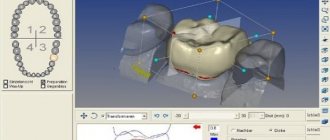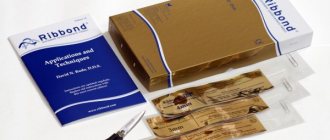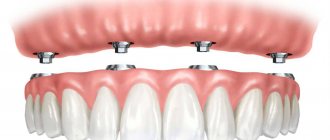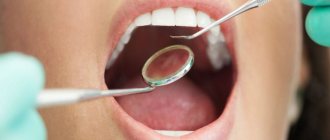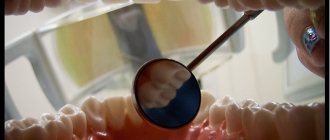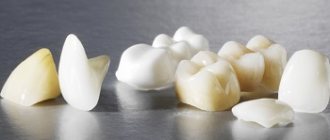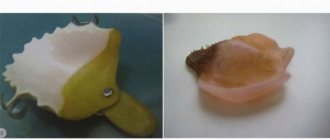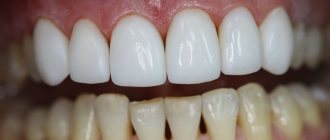2014
Gypsum is formed as a result of drying out water bodies by deposition of sediment from compounds saturated with sulfate salts, or by weathering of rocks.
This material, created by nature, is considered to be the most common auxiliary mass in dentistry, the demand for which has not decreased over the years due to its beneficial properties.
A little bit of history
People knew about its unique properties back in ancient times. Gypsum was originally used as a building material. Even before our era, it was used in Egypt for the construction of pyramids and other architectural structures.
Mass mining of the material began around the 12th–13th centuries. ad. Based on water, it began to be used throughout construction for plastering and finishing work. Various architectural elements were made from gypsum.
In the middle of the 19th century, or more precisely, at the height of the Crimean War, the Russian surgeon N. I. Pirogov was the first to use plaster mass during the treatment of bone fractures received from a gunshot wound.
To fix the bone fragments, he used bandages soaked in liquid plaster. A similar technique is actively used in surgery today.
In orthopedic dentistry, gypsum has a wide range of applications. For a long time it remained the only impression material.
In dental prosthetics, the material is necessary when plastering wax bases with artificial units in a cuvette and models in an occluder, and in the manufacture of metal dentures - to obtain a stamp sample. When making bridge systems, the technician uses plaster to temporarily hold teeth and crowns together .
The material can be used as a modeling material, when all elements are molded from it before casting a metal prosthesis. Extra finely ground gypsum powder is often used for polishing finished prosthetic structures.
Where can I buy
Medical gypsum is produced by companies that produce products for construction and finishing works. Its main difference from gypsum for construction purposes is the degree of grinding, and as a result, faster hardening times. You can purchase plaster for medical practice directly from the manufacturer. One of the leading companies is Volma.
Description of material
In nature, the material is an aqueous potassium sulfate salt. In other words, it is a mineral whose crystal lattice is layered, distinguished by the regular arrangement of atoms.
The crystals are colorless and almost transparent, but due to the presence of various impurities (usually quartz, clay, carbonates, pyrite), they have a pink, yellow or black tint. The material is extremely rare in nature without impurities.
To obtain semi-aqueous gypsum, the natural composition is purified from all kinds of impurities. Then it is crushed in special crushers to a powdery state, loaded into boilers and fired for 10-12 hours at 150-190°C.
Based on how much and at what pressure and temperature the gypsum was fired, different grades of it are obtained, differing in strength and hardening period.
You can get plaster of two modifications:
- α-gypsum. The structure is durable, has a small specific surface area, low water requirement, high strength and a long setting period.
- β-gypsum. It is characterized by pronounced reactivity, a wide internal surface, low strength compared to α-gypsum, and requires a larger volume of water for dissolution.
As a dental material, plaster has the following characteristics:
- available;
- allows you to obtain accurate impressions;
- safe;
- tasteless and odorless;
- fragile;
- very low shrinkage rate;
- insoluble in saliva;
- does not swell when wetted with water;
- Easily removed from models using simple release agents (for example, soap solution).
What is dental plaster
To understand the essence of what this dental material is, what stages of processing it goes through before starting to manufacture structures from it, it is worth finding out how it differs from natural gypsum and how it is obtained.
The territory of Russia is rich in minerals, including gypsum, the main deposits of which are concentrated in the Tula, Irkutsk regions, Perm and Krasnodar territories.
When mined, it appears as solid crystals of green, pink, yellow or brown. Pure gypsum is colorless, but due to the admixtures of quartz, pyrite, carbonates, and clay, this natural material acquires color. It is extremely rare without impurities.
Before plaster becomes suitable for use in dentistry, it undergoes special processing. It needs to be converted from its natural state - calcium sulfate dihydrate - to calcium sulfate hemihydrate. To do this, the material is crushed to a powder state. The crushing process in the mill is accompanied by simultaneous heating.
Main methods of obtaining:
- under conditions of high pressure - in an autoclave, for 6 hours at a temperature of 120-124 °C. After this, the material is dried, resulting in α-hemihydrate;
- under normal atmospheric pressure - for 12 hours at temperatures up to 165 °C. In this way the β-hemihydrate is obtained.
The resulting powder is carefully sifted and the following is added to its composition:
- catalysts and inhibitors - substances that affect strength characteristics and solidification rate;
- dyes that give a wide variety of colors;
- flavorings (for example, the taste of “mint” - to increase the patient’s comfort).
The essence of the process described above comes down to the fact that as a result the material acquires strength and the ability to set. The finer the powder is ground, the higher these characteristics are. Compliance with the temperature regime is of particular importance: insufficiently high temperatures leave excess water in the plaster, which prevents its hardening.
When the temperature is exceeded, all the water evaporates and anhydride forms, which sets too quickly. If absolutely all the water evaporates when heated, a material is formed that is incapable of setting. After obtaining hemihydrides, dental materials are prepared from them for various purposes.
Composition and technical characteristics
In terms of its composition, dental gypsum is calcium sulfate dihydrate (CaS04 - 2H20). This is a sedimentary rock with a layered crystal lattice, formed by precipitated sulfate salts.
Gypsum is traditionally mined in lakes and lagoons from aqueous solutions through drying. Also, deposits of natural gypsum are found in mountainous areas along with limestones, rock salt, and clays.
Temperature treatment (firing or calcination) transforms the substance into calcium sulfate hemihydrate (CaS04)2 - H20, further heating - into anhydrite.
In dental practice, a semi-aqueous modification of gypsum is used, which has a number of necessary characteristics, namely:
- dimensional stability and accuracy;
- excellent color contrast;
- environmental safety;
- lack of taste and smell;
- insolubility under the influence of saliva;
- low shrinkage rates;
- affordable price.
When choosing an auxiliary material, it is necessary to pay attention to strength indicators, the degree of water absorption, the absence of metal impurities, the proportion of hydration water and volumetric expansion values.
Manufacturers supply gypsum powder in bags made of paper or cellophane impregnated with a water-repellent substance and packaged in jars equipped with ground-in lids. The packaging must contain information about the trade name of the product, information about the manufacturer and supplier, gypsum class, scope of use, color characteristics, net indicators. Also on the packaging there are recommendations about the rules and shelf life, and the batch number.
How do you get the material?
The crystals are colorless and transparent. However, all kinds of impurities, such as clay, pyrite, quartz or carbonate, color them in various shades - from pink to black. To obtain dental gypsum, the material at the first stage is cleaned of impurities and crushed to a powder state.
Next, the natural material is heated to a temperature sufficient to remove some of the water. There are several manufacturing methods. As a result of their use, medical, model plaster and super plaster are obtained. The composition of medical gypsum of all varieties is identical - (CaS04)2 - H20.
The material differs in structure and particle shape:
- The hemihydrate obtained by firing is medical gypsum (β-hemihydrate). The process of its manufacture is heating in an open boiler until some of the moisture evaporates. The material turns out to be porous and loose. Before use in dental practice, the powder is mixed with water in a 2:1 ratio.
- Model plaster (a-hemihydrate) is produced by autoclaving. When mixing non-porous powder with water, the following proportions are used - 5 parts of gypsum particles to 1-1.5 parts of water.
- To obtain super dental gypsum, the boiling method with the addition of chloride (magnesium or calcium) is used. Chlorides act as deflocculants, preventing the formation of flocs and promoting particle separation. When adding water, the traditional ratio is 5:1.
This is interesting: Caring for dentures - the subtleties of polishing and the tools used
Video from a specialist:
How does medical plaster work?
For dental purposes, gypsum dihydrate is heated under the required pressure, mixed with water, after which the entire mixture hardens. The degree of hardening of gypsum is influenced by the following conditions: temperature, dispersion, mixing technique, quality and presence of impurities.
For conservative and post-surgical treatment of fractures and soft tissue damage, immobilization with plaster casts is widely used, which is the best means for external fixation of extremity bone fractures.
It is believed that the method of preparing and applying GP was first described by the Dutch physician A. Mathisen (1852), and in 1854, during the Crimean War, it was described and widely used by M.I. Pirogov. He also paid great attention to caring for the condition of the casted limb.
Gypsum quality control
As mentioned earlier, the quality of gypsum is directly proportional to proper firing and other factors - humidity, amount of water for mixing, etc. In connection with these parameters, there is quality control of gypsum, which consists of testing:
- for strength - a ball is made with a diameter of 1.5-2.5 cm. Descends from a height of 1.5 m to the floor - normally remains intact;
- for flowability - gypsum powder is compressed in a fist - normally there should be no lumps left in the palm, plaster seeps between the fingers;
- for humidity - the plaster is heated on a metal plate with a mirror held over it. If the plaster is of high quality and not damp, then the mirror will not fog up;
- for hardening - a paste-like mass is made (2 parts water and 3 parts gypsum), which hardens within 10-12 minutes and does not crumble when broken;
- for viscosity - make a plaster splint (4-5 layers), apply it to the forearm, after hardening it should retain its given shape, not crumble or delaminate;
- odor - if the gypsum is unsuitable when mixed with water, the smell of hydrogen sulfide (rotten eggs) appears.
Classification
According to GOST No. R51887-2002, ISO 6873, gypsum is divided into 5 classes. This classification is based on the degree of its hardness and scope of application:
- Impression. It has low hardness and a minimal expansion coefficient, quickly hardens, pliable and fairly soft material. Suitable for taking impressions, including those with complete edentia.
- Medical .
Characterized by a normal degree of hardness. It is used for diagnostic models, as well as samples for planning the type and size of a future orthopedic product. Due to insufficient strength, gypsum of this class cannot be used to create working models. - Highly durable .
Belonging to the class of hard minerals, the material has a high strength coefficient. It is applicable for creating removable complete prosthetic systems, prostheses that replace some of the missing units, and is also used in creating a base of fixed, collapsible systems and other similar structures. - Ultra-strong for dies and models with a low expansion coefficient , also in the production of disassembled jaw samples and the implementation of any combined work.
- Extra hard with an adjustable expansion coefficient and the addition of synthetic compounds. This is a rarely used type of plaster, needed to create models that require special precision.
Types of impression materials in orthopedic dentistry, their properties and applications.
Visit here to learn more about diagnostic wax-ups.
At this address https://www.vash-dentist.ru/protezirovanie/nesemnyie-p/slepok-zubov.html we will tell you how to make a dental impression.
Compressive and bending strength
The grade of gypsum is determined by testing standard samples for compression and bending - beams 4 x 4 x 16 cm 2 hours after their molding. During this time, hydration and crystallization of the gypsum ends.
12 grades of gypsum have been established in terms of strength from 2 to 25 (the number shows the lower limit of the compressive strength of a given grade of gypsum in MPa). In construction, gypsum grades 4 to 7 are mainly used.
According to GOST 125-79 (ST SEV 826-77), depending on the compressive strength, the following grades of gypsum binders are distinguished:
| Binder grade | Minimum tensile strength of beam samples with dimensions 40x40x160 mm at the age of 2 hours, MPa (kgf/cm2), not less | |
| when compressed | when bending | |
| G-2 | 2(20) | 1,2(12) |
| G-3 | 3(30) | 1,8(18) |
| G-4 | 4(40) | 2,0(20) |
| G-5 | 5(50) | 2,5(25) |
| G-6 | 6(60) | 3,0(30) |
| G-7 | 7(70) | 3,5(35) |
| G-10 | 10(100) | 4,5(45) |
| G-13 | 13(130) | 5,5(55) |
| G-16 | 16(160) | 6,0(60) |
| G-19 | 19(190) | 6,5(65) |
| G-22 | 22(220) | 7,0(70) |
| G-25 | 25(250) | 8,0(80) |
When moistened, hardened gypsum not only significantly (2-3 times) reduces strength, but also exhibits an undesirable property - creep - a slow irreversible change in size and shape under load.
Terms of use
It is important for all specialists working with gypsum mass to adhere to the following rules:
- The material should be kept in a dry place.
- Before filling the storage container with a new portion, it must be thoroughly cleaned.
- All accessories and equipment used to work with plaster must be cleaned after each use.
- A single portion of material should not exceed the volume required to fill 2-3 prints.
- To speed up the hardening of the product, it is not recommended to add hardening accelerators to it. If necessary, it is better to take a quick-hardening brand of gypsum. By increasing the time for mixing the material by a couple of seconds, you can speed up its subsequent hardening.
- To prevent the expansion of the mass from exceeding the required parameters, when mixing, the proportions of water and added powder should be observed.
- The temperature of water and gypsum powder should be 19-20°C. A deviation of this indicator by 1°C upward or downward is allowed.
- The powder must be poured into the water slowly, while giving it time to completely immerse in it. Then within 1 min. Gently mix the mixture with a spatula. Following manual mixing, machine mixing should last no more than 30 seconds.
- The composition is poured into the mold immediately upon completion of mixing. It is unacceptable to increase the pouring time of the mixture or add water to it.
- The impression can be removed only after the temperature in the model has decreased.
Compliance with the listed rules will allow specialists to work with plaster comfortably, economically and quickly.
Hand kneading technology
You can get a high-quality plaster cast only if you follow the mixing sequence:
- Distilled water is poured into a special bowl, the amount of which is determined by the class of the powder.
- Gypsum powder is slowly poured into the liquid. According to standards, about 10 seconds should pass from the start of contact of the first particles with water to the end of falling asleep.
- After this, you should wait until the particles are completely immersed in water and only then start mixing with a metal or plastic spatula.
- Movements should be as energetic as possible. The consistency of the complete mixture is creamy and homogeneous.
If too much water is added, the plaster will only absorb the amount it needs. The remaining water will quickly make the structure of the material loose and reduce the accuracy of the impression. Not the best solution would be to add less liquid than required by the technology for producing the mixture. Thick plaster does not make it possible to obtain an accurate imprint due to the formation of air bubbles that simply do not have time to reach the surface due to too rapid hardening.
Taking an impression of the upper jaw on video:
Application Basics
In order for the manufactured orthopedic structure to be of high quality and meet all technical standards, when working with plaster, all stages of working with it must be followed exactly.
Preparation
Before you begin mixing, you must check that all equipment that will be used in this process is clean and dry.
The remains of the old material in the flask or on the spatula will provoke changes in the timing of expansion and hardening of the new gypsum mass.
It is advisable to mix any type of gypsum under vacuum conditions and with strict adherence to the proportions of all components.
Approximate measurements of ingredients will certainly lead to changes in characteristics and properties.
The mixing force and duration parameters must also match those recommended by the manufacturer.
Water used
To obtain the mixture, tap water is taken that has undergone a period of settling, the temperature of which does not exceed 20(±1)°C.
If the water has high hardness, the hardening time of the mixture is reduced . In this situation, you should take demineralized water.
Powder addition
The gypsum should be poured into the water evenly, but at the same time quickly (the approximate time for adding a portion of powder is 10 seconds). According to the new regulations, this time should be counted from the moment the powder touches the liquid.
Before you start mixing the mixture with a spatula, you must wait until the poured product is completely immersed in water (this takes about 20 seconds).
The mixing time for different classes of gypsum differs. Thus, first-class material is mixed manually for only 30 seconds. Classes 2 to 4, which are alabaster, hard and super hard, are kneaded for 1 minute.
Features of the production of removable dentures with Ivoclar teeth, advantages and disadvantages of the design.
In this publication you can familiarize yourself with the classification of toothless jaws according to Schroeder.
Here https://www.vash-dentist.ru/protezirovanie/semnyie-p/perebazirovki.html we’ll talk about modern material used for relining removable dentures.
Unboxing
According to the standard, the frozen sample is removed from the cast after approximately 30 minutes from the point of pouring. Hydrocolloid (alginate) impressions, after being cleaned, neutralized and disinfected, are cast in plaster because they do not hold a constant volume. Having an aggressive effect on the plaster, unpacking is completed in half an hour.
Important! If other impression materials are used, it is recommended to carry out late unpacking, i.e. after an hour.
Extension
Each class of material expands slightly as it hardens. This indicator is influenced by:
- compound;
- air humidity;
- ambient temperature.
To compare the degree of expansion of different classes, they must be placed in equal conditions.
The permissible expansion values for each class of a given material are given in accordance with ISO 6373 or EN 26873.
Following the standards, the expansion of the product should be indicated in % and after 2 hours, and the strength of the applied impact - after 1 hour (in N/mm2).
If the sample is kept at room temperature and insufficient humidity longer, its expansion decreases by approximately 30%. But in practice it is known that gypsum even needs a slight expansion - it covers the shrinkage of other materials .
Kneading
The process carried out in a vacuum apparatus, as a rule, has a good effect on the material. Machine kneading reduces the time required to obtain a high-quality mixture by almost 2 times compared to hand kneading, i.e., if kneading by hand takes about 1 minute, then kneading by machine takes no more than 30 seconds.
First class gypsum is usually mixed by hand. Adding water to it to thin the consistency or powder to thicken it is not recommended.
Due to such actions, the structure of the material may be disrupted, which will certainly affect the process of its hardening.
Fill
The finished mass should be poured into molds almost immediately. It should not be mixed for more than 2-3 pours.
Important! The time spent on pouring is included in the total time allocated for processing the gypsum.
Upon completion of the period allotted for manipulation, crystals begin to form in the material, and subsequent work with it will be useless.
Also, once the process has begun, detailed reproduction of small elements becomes impossible, and strength is significantly reduced.
These facts must be considered when using a vibrator. Although the use of the apparatus has a positive effect on the characteristics of the finished mixture, vibration should not be continued once hardening has begun.
Modeling
When the shine disappears from the surface of the plaster, within 1 minute. You can make the desired models from it and cut them.
The duration of subsequent hardening is different for each class of gypsum. Thus, this period for hard grades (grade 3) of material is approximately 10-13 minutes. Some of the super hard varieties have a longer cure time.
Model defects
To avoid unpleasant moments, the plane between the gypsum and alginate (hydrocolloid) mass must be processed. The impression based on the alginate mixture is neutralized with water, gypsum powder or a trimmer. This treatment prevents areas that have not yet hardened from spreading over the surface of the sample.
Casts made from a hydrocolloid mixture should be placed in a potassium carbonate or potassium sulfate solution for neutralization. When using impression material with polyester, the manufacturer's instructions must be followed.
Wetting models
Samples should not be subject to harsh effects. If the technology requires steam treatment, the likelihood of their destruction can be reduced by pre-wetting.
Cleaning with a steam jet can cause rapid wear of the surface and level out contours. For this reason, it is best to clean samples with a soft-bristled brush and a special detergent.
Damage to used models during sawing or during preparation can be avoided if they are wetted briefly.
As practice shows, it is most reasonable to work with synthetic varieties of gypsum. The presence of mineral components in it leads to the fact that the expansion process lasts much longer and sometimes reaches up to 30 minutes in some varieties.
It's rare that a technician can wait all this time and start working with wax. If errors occur during modeling, they are not due to non-compliance with the technology of working with wax, but due to the fact that the expansion of the gypsum has not yet finished.
How to avoid defects in model making
From the description of the technology for making models from dental plaster, it is clear that there are subtleties that must be observed to avoid defects. Let's list the main ones.
First of all, the condition of the jaw impression being filled with wax: it must be free of saliva. Another important aspect is that the structure of the material used is porous. The use of vibrating tables minimizes the risk of cavities.
If there is no such equipment, watch your own manipulations. Be careful when separating the model from the print; if necessary, tap it with a special hammer. Use isolating solutions before pouring the dental plaster to make it easier to separate the model from the impression.
During work, always pay due attention to maintaining the required temperatures of water and material, their proportions, and consistency. Be aware of proper storage conditions, containers and tools. To achieve the highest quality and fastest results, combine, if possible, manual and machine processing.
Wetting the model
Sudden temperature changes can increase the fragility of the plaster model, which can cause it to wear out quickly.
Therefore, if steam or other heat treatment is necessary, it is recommended to moisten the sample.
Also, short wetting helps prevent the structure from breaking during sawing or preparation.
From the video you will learn how to create a plaster model.
Model defects
To avoid spreading of the sample and other unpleasant surprises, the cavity between the gypsum composition and the alginate mass should be treated.
For this, a neutralizing solution, water or dry gypsum powder can be used . Instructions for using polyester impression material are indicated in the instructions.
Shelf life
Gypsum should always be packaged in a moisture-proof container that does not alter its physical and chemical properties. The container must be clearly marked.
It must indicate:
- trade (factory) name of the product;
- the name of the manufacturer and supplier, as well as their address;
- gypsum class;
- the intended scope of its application;
- color (if it is not white);
- smell;
- net indicator;
- indication of the expiration date of the period of application;
- basic storage rules with the obligatory indication that gypsum is susceptible to deterioration at atmospheric pressure and high humidity;
- Issued batch number.
Transportation and subsequent storage is possible only in the original packaging. The shelf life during which the manufacturer guarantees the quality of the released material and the preservation of characteristics subject to storage rules is 1 year.
The video provides additional information on the topic of the article.
Reviews
Plaster is a versatile dental material. The stability of its characteristics and quality, as well as its correct use, facilitate the work of specialists and increase the aesthetic and functional characteristics of prosthetic structures.
At the same time, the material improves the outcome of human treatment, and therefore affects the quality of his life.
You can share your opinion about the advisability of using gypsum in dentistry and its role in dental prosthetics by leaving it in the comments to this article.
If you find an error, please select a piece of text and press Ctrl+Enter.
Tags: gypsum in dentistry, dentures
Did you like the article? stay tuned
Previous article
The procedure for polishing a prosthesis to improve strength and aesthetic qualities
Next article
What is a direct abutment and for what purpose is it used?
Necessary procedures before bone augmentation
Once a molar or premolar is removed, the bone is no longer subject to regular stress, which over time causes it to atrophy and lose volume. Along with this, inflammatory processes appear in periodontal tissue. As a result, the more days that pass after the loss of a molar or premolar, the more the bone begins to become deficient. Against this background, it becomes much more difficult to carry out implantation.
The technique used to increase bone tissue volume is selected individually in each clinical case. To do this, the dentist first evaluates the oral cavity and, if necessary, prescribes instrumental diagnostics. It often happens that the need to use another technique arises only during the period of surgical intervention. Due to this, the specialist must be aware of all types of osteoplasty and be able to apply them in practice.
